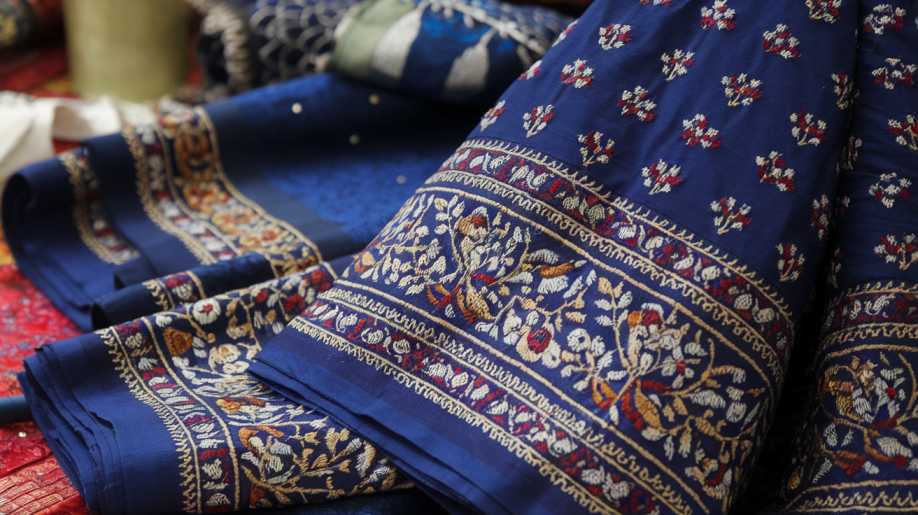Artful Weaves: The Craftsmanship That Defines Habaspuri Borders and Motifs
The Habaspuri weaving tradition, native to the tribal regions of Odisha, India, is renowned for its intricate borders and motifs. The artisans weave saris that reflect deep cultural significance, blending artistry with heritage. The artisans meticulously craft the borders, often adorning them with geometric and nature-inspired designs, which symbolize the region’s connection to nature and tribal life. Each motif tells a unique story, passed down through generations of skilled artisans. Despite modern challenges, Habaspuri weaving stands as a testament to the rich textile traditions of India, celebrated for its craftsmanship and cultural importance in traditional attire.
Mastering the Craft
- Meticulous Hand Weaving Process: The borders of Habaspuri saris are woven by hand on traditional looms, requiring great skill and precision. Artisans carefully interlace threads, ensuring the borders are strong and visually appealing. This painstaking process often takes days or even weeks to complete.
- Geometric and Symbolic Patterns: Habaspuri borders typically feature geometric designs, including diamonds, zigzags, and symmetrical patterns. These designs often carry cultural and symbolic meanings, reflecting tribal heritage and the local environment, such as hills, rivers, and flora.
- Attention to Detail: Artisans pay close attention to the spacing, alignment, and proportion of each element in the border. This ensures uniformity throughout the sari’s length and maintains a balance between the border and the body of the fabric.
- Color Contrasts and Harmonies: The borders often use bold color contrasts, such as deep reds, blacks, and whites. These hues come from natural dyes, which bring vibrancy and improve the visual contrast between the borders and the main body of the sari.
- Cultural Expression: Each design within the border serves as a form of storytelling, capturing elements of the weavers’ cultural beliefs, daily life, and traditions. The borders are not only decorative but also a representation of the artisan’s personal and community identity.
Meticulous Motifs
- Nature-Inspired Motifs: Many Habaspuri motifs draw inspiration from nature, symbolizing the close bond between the tribal communities and their surroundings. Common motifs include flowers, leaves, birds, and animals, which are intricately woven into the fabric. Each motif has its own cultural significance, often reflecting local beliefs or stories.
- Geometric Designs: Geometric motifs are a hallmark of Habaspuri weaving, including patterns like diamonds, hexagons, and zigzags. These designs not only create visual interest but also carry symbolic meaning related to order, balance, and the interconnectedness of life.
- Cultural and Mythological Symbols: The motifs also reflect cultural and mythological themes. Some designs represent gods, spirits, or tribal deities, while others might depict ritual objects or sacred animals, representing the weavers’ spiritual and cultural beliefs.
- Textural Variations: Motifs in Habaspuri weaving can vary in texture, with some being raised for a 3D effect. This contrast in texture highlights the motif and brings an added level of elegance to the overall design.
- Customization and Personalization: Artisans traditionally customized motifs to represent personal or family identities. Certain motifs signify special occasions like weddings or celebrations, while others mark social status or tribal affiliations.
- Symbolism in Color Choices: The colors used in these motifs are just as important as the patterns themselves. For instance, red often represents strength, while yellow may symbolize prosperity or fertility, adding another layer of meaning to the overall design.
Tools and Materials
- Traditional Looms: Handlooms, often passed down through generations, are used to weave Habaspuri saris. These looms require skilled handling to create intricate patterns and borders.
- Cotton Yarn: The primary material used is cotton yarn, spun manually by artisans. It is soft yet durable, making it ideal for weaving delicate and long-lasting fabrics.
- Natural Dyes: Natural dyes, sourced from plants, minerals, and occasionally insects, produce vivid colors. Common colors include reds, blacks, and yellows.
- Shuttle and Spindle: Essential for weaving, the shuttle carries the weft thread while the spindle spins the yarn, both requiring steady hands and precision.
- Reeds and Hooks: Reeds pack the threads tightly together to ensure even weaving, while hooks help fine-tune intricate motifs and designs.
- Tassels and Embellishments: Traditional Habaspuri saris may include tassels or other embellishments added by hand to enhance the beauty and authenticity of the final piece.
Preserving Perfection
- Decline of Traditional Skills: The younger generation is increasingly moving away from traditional weaving due to economic pressures and the allure of urban jobs, leading to a loss of expertise.
- Competition from Machine-Made Fabrics: Machine-produced fabrics are cheaper and more readily available, reducing demand for handwoven Habaspuri saris.
- Lack of Market Access: Many artisans struggle with limited access to markets, reducing their income and discouraging the craft’s continuation.
- Government and NGO Initiatives: Efforts to revive the craft include government support, training programs, and craft fairs to provide exposure and boost sales.
- Cultural Revitalization: Increasing interest in handmade, sustainable products offers an opportunity to preserve and promote Habaspuri weaving.
Closing Thoughts
The Habaspuri weaving tradition, with its intricate borders and motifs, remains a vibrant expression of cultural heritage and craftsmanship. Even with obstacles like the fading of traditional skills and competition from machine-produced fabrics, initiatives to protect and rejuvenate the craft are gaining momentum. By supporting artisans through initiatives, promoting sustainable fashion, and recognizing the deep cultural significance of these handwoven saris, we can ensure that this exquisite art form thrives for generations to come. Skilled artisans weave Habaspuri saris as narratives rich with history, symbolism, and an enduring legacy.


